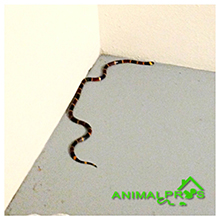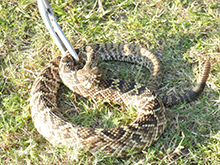[raw]
[tabs style=”framed” nav=”tabs” tab_1=”Problems” tab_2=”Non Venomous” tab_3=”Venomous” tab_4=”Identification”]
[tab_1]
In Home
In Attic
Under The Home
Skins Found In Basement
In Insulation
Climbing Walls
In Yard
In Pool
In Pond
[/tab_1]
[tab_2]
Non-Venomous Snakes Of Florida
Common Gartersnake
Common Kingsnake
Eastern Hog-nosed Snake
Gray Ratsnake
North American Racer
Red Cornsnake
Scarlet Kingsnake
[/tab_2]
[tab_3]
Venomous Snakes in Florida
Timber Rattlesnake
Copperhead
Water Moccasin
Pigmy Rattlesnake
Eastern Coral Snake
Eastern Diamondback Rattlesnake
[/tab_3]
[tab_4]
Snake Identification
Found a snake, it it venomous or not?
Need help identifying a snake
Snake is rattling its tail like a rattlesnake[/tab_4]
[/tabs]
[/raw]
Venomous Snakes in Jacksonville
There are 6 species of venomous snakes in Florida including the Eastern Diamondback Rattlesnake, Copperhead, Water Moccasin, Coral Snake, and the Pigmy Rattlesnake.
All are pit vipers, containing the heat seeking pit located between the eye and nostril, or elapids known for having large hollow fangs to inject venom. While many snakes are mistaken for being venomous, they may resemble or mimic actions of a venomous snake.
- Pigmy Rattlesnake
- Timber Rattlesnake
- Eastern Coral Snake
- Eastern Diamondback Rattlesnake
- Water Moccasin
- Copperhead
Eastern Coral Snake (Micrurus fulvius)
The Eastern Coral Snake more commonly identified by its black, yellow, and red rings, on average will range between 25″ and 30″ plus in length. They are found throughout Florida, and are often mistaken for non venomous Scarlet Kingsnakes or Scarlet Snakes. The Coral Snake will have smooth scales, and are venomous. They can be easily distinguished by “if red touches yellow, kill a fellow” or nonvenomous Scarlet King Snake “if red touches black, venom lack”. Coral Snakes breed in May – June late spring, laying a sigle clutch of six eggs, often hatched in late summer. Coral Snakes can be highly dangerous as they are venomous, with 20% of bites being fatal.
Easter Diamondback Rattlesnake (Crotalus adamanteus)
The Eastern Diamonback Rattlesnake is the largest venomous snake in Florida averaging in size between 3′-6′ ft and longer, and adults weighing as much as 5 – 10 lbs. It is potentially one of the most dangeous reptiles in the world. The Eastern Diamondback Rattlesnake is found throught Florida, and while the percieved threat from the public is high, the real threat is low, as there is more people harmed and killed by dogs and bees. They are venomous, and strikes do occur, so always beaware of your surroundings. Mating occurs in spring and fall, with as many as 12-24 young born in late summer or early fall August – November. Young Eastern diamondback Rattlesnakes possess enough venom to kill a grown man.
Timber Rattlesnake (Crotalus horridus)
The Timber Rattlesnake or (Canebrake Rattlesnake) can on average grow between 35″ and 60″ long. Average weight of a Timber Rattlesnake can be between on average 1-3 lbs, with some large specimens reaching nearly 10lbs. They are usually active between March through October, but depending on geographical location and warmer temperatures, can still be active on winter days. Timber Rattlesnakes give birth between August through late September to live young and can have as many as 14 young. They ares capable of living in the wild 12 years to as many as 30 years, and typically will den up or congregate during winter. Typical food sources of the Timber Rattlesnake can consist of small mammals, including squirrels, birds, amphibians, and even other snakes. Usually shedding its skin every year a new rattle segment will grow, or button on its rattle. The venom of the Timber Rattlesnake is used to immobilize prey, but can be fatal to people if a untreated bite occurs. Venom of a rattlesnake stops blood from clotting, and can destroy tissue and organs. If you happen to be struck, seek medical attention immediately.
Copperhead (Agkistrodon contortrix contortrix)
Copperheads are well known from their copper appearance and colorations, as well as being the most responsible for occuring snake bites. Most bites occur when the snake is stepped on or near, and may be a dry bite where very little to no venom is injected. Most bites are a reaction strike, and Copperheads will not hesitate to strike. Their copper patterns can make them incredibly hard to spot among leaves as they blend right in. Adults can measure 2-3 ft, as some can be longer. They are usually active between February – October, and mating occurs between February to May and again in late fall from August to October. Copperheads can have between 2-18 young usually a grayer color. Young Copperheads are born with a bright yellow tail, and as they lay motionless, can flick the tail giving off the apperance of a caterpillar (Caudal Luring) for a unsuspecting lizard or frog. Copperheads can live as many as 20 years in the wild.
Water Moccasin (Agkistrodon piscivorus)
The Water Moccasin or (Cottonmouth) is widely known for its white mouth as it opens warning someone that they are too close and it will bite. Water Moccasins typically range between 31″ to 70″ in length, and can weigh up to 10lbs. Although coloration may be totally black, they can range in colors from tan, olive, brown, yellowish, or grey patterns. Water Moccasins are the most aquatic venomous snake ofter being found near or close to water. They give birth to live young and can range from 1 to as many as 20 young during August through October, although mating can occur during any of the warmer months. They mostly feed on fish, reptiles, amphibians, small mammals, birds, and will feed on other snakes, even their own kind. Water Moccasins can be active almost year round, as they are the last snake species to den up in winter. They also happen to have the reptation for being the most aggressive.
Pigmy Rattlesnake (Sistrurus miliarius)
The Pigmy Rattlesnake has a very small rattle compared to other rattlesnakes which can seldomly be heard and it blends in with ground cover exceptionally well. They only average between 14″ an 30″ in length. They are active March through October and can give live birth to 3-8 young.
Preferred foods of the Pygmy tend to be lizards, frogs, and small rodents. Do not let their size fool you. They will act much larger and can be aggressive. With heat sensory pits it allows the snake to detect and accurately strike warm bodied prey.
Non Venomous Snakes of Florida
There are 40+ species of non venomous snakes in Florida that rarely pose a threat to people, but will imitate venomous snakes in similar ways including color patterns or behaviors, causing a panic within close proximity of your home. Snakes, believe it or not, are beneficial to the environment keeping in check numbers of rodents, lizards, frogs, and insects. The best thing you can do if you spot a snake is leave it alone to slither off, unless it is in the interior of your home, or a threat to children or your pets, then professional help is needed. Contact Animal Pros specialists for immediate 24/7 snake removal and identification help.
- Sarlet Snake (Cemophora coccinea)
- Florida Scarlet Snake (Cemophora coccinea coccinea)
- Northern Scarlet Snake (Cemophora coccinea copei)
- Eastern Racer (Coluber constrictor)
- Brownchin Racer (Coluber constrictor helvigularis)
- Everglades Racer (Coluber constrictor paludicola)
- Southern Black Racer (Coluber constrictor priapus)
- Ringneck Snake (Diadophis punctatus)
- Key Ringneck Snake (Diaophis puntatus acricus)
- Southern Ringneck Snake (Diadophis punctatus punctatus)
- Eastern Indigo Snake (Drymarchon couperi)
- Boa Constrictor (Boa constrictor)
- Mud Snake (Farancia abacura)
- Eastern Mud Snake (Farancia abacura abacura)
- Western Mud Snake (Farancia abucura reinwardtii)
- Rainbow Snake (Farancia erytogramma)
- Southern Florida Rainbow Snake (Farancia erytogramma seminola)
- Rainbow Snake (Farancia erytogramma erytogramma)
- Eastern Hognose Snake (Heterodon simus)
- Mole Kingsnake (Lampropeltis calligaster)
- Southern Florida Mole Kingsnake (Lampropeltis calligaster occipitolineata)
- Mole Kingsnake ((Lampropeltis calligaster rhombomaculata)
- Scarlet Kingsnake (Lampropeltis elapsoides)
- Short-Tailed Kingsnake (Lampropeltis exenuata)
- Kingsnake (Lampropeltis getula)
- Florida Kingsnake (Lampropeltis getula floridana)
- Eastern Kingsnake Kingsnake (Lampropeltis getula getula)
- Eastern Apalachicola Lowlands Kingsnake (Lampropeltis getula meansi)
- Eastern Coachwhip (Masticophis flagellum flagellum)
- Salt Marsh Snake (Nerodia clarkii)
- Gulf Salt Marsh Snake (Nerodia clarkii clarkii)
- Mangrove Salt Marsh Snake (Nerodia clarkii compressicauda)
- Atlantic Salt Marsh Snake (Nerodia clarkii taeniata)
- Mississippi Green Water Snake (Nerodia cyclopion)
- Plainbelly Water Snake (Nerodia erythrogaster)
- Redbelly Water Snake (Nerodia erythrogaster erythrogaster)
- Yellowbelly Water Snake (Nerodia erythrogaster flavigaster)
- Southern Water Snake (Nerodia fasciata)
- Banded Water Snake (Nerodia fasciata fasciata)
- Florida Water Snake (Nerodia pictiventris)
- Florida Green Water Snake (Nerodia floridana)
- Midland Water Snake (Nerodia sipedon pleuralis)
- Brown Water Snake (Nerodia taxispilota)
- Rough Green Snake (Opheodrys aestrivus)
- Northern Rough Green Snake (Opheodrys aestrivus aestrivus)
- Florida Rough Green Snake (Opheodrys aestrivus carinatus)
- Eastern Rat Snake (Pantherophis alleghaniensis)
- Eastern Corn Snake (Pantherophis guttatus)
- Gray Rat snake (Pantherophis spiloides)
- Pine snake (Pituophis melanoleucus)
- Black Pine Snake (Pituophis melanoleucus lodingi)
- Florida Pine Snake (Pituophis melanoleucus mugitus)
- Burmese Python (Python bivittatus)
- Northern African Python (Python sebae)
- Brahminy Blind Snake (Ramphotyphlops braminus)
- Striped Crayfish Snake (Regina alleni)
- Glossy Crayfish Snake (Regina rigida)
- Gulf Crayfish Snake (Regina rigida rigida)
- Queen Snake (Regina septemvittata)
- Pine Woods Snake (Rhadinaea flavilata)
- Swamp Snake (Seminatrix pygaea)
- Southern Florida Swamp Snake (Seminatrix pygaea cyclas)
- Northern Florida Swamp Snake (Seminatrix pygaea pygaea)
- Brown Snake (Storeria dekayi)
- Marsh Brown Snake (Storeria dekayi limnetes)
- Midland Brown Snake (Storeria dekayi wrightorum)
- Redbelly Snake (Storeria occipitomaculata)
- Florida Redbelly Snake (Storeria occipitomaculata obscura)
- Northern Redbelly Snake (Storeria occipitomaculata occipitomaculata)
- Florida Brown Snake (Storeria victa)
- Southeaster Crowned Snake (Tantilla coronata)
- Rim Rock Crowned Snake (Tantilla oolitica)
- Florida Crowned Snake (Tantilla relicta)
- Central Florida Crowned Snake (Tantilla relicta neilli)
- Peninsula Crowned Snake (Tantilla relicta relicta)
- Coastal Dunes Crowned Snake (Tantilla relicta pamlica)
- Eastern Ribbon Snake (Thamnophis sauritus)
- Bluestripe Ribbon Snake (Thamnophis sauritus nitae)
- Peninsula Ribbon Snake (Thamnophis sauritus sackenii)
- Garter Snake (Thamnophis sirtalis)
- Eastern Garter Snake (Thamnophis sirtalis sirtalis)
- Bluestipe Garter snake (Thamnophis sirtalis similis)
- Rough Earth snake (Virginia striatula)
- Eastern Smooth Earth Snake (Virginia valeriae valeriae)






